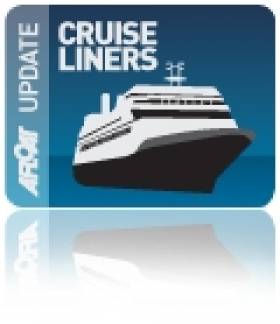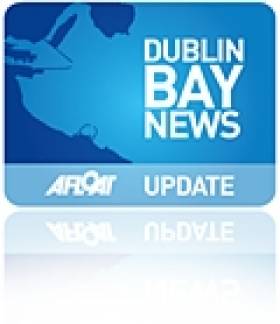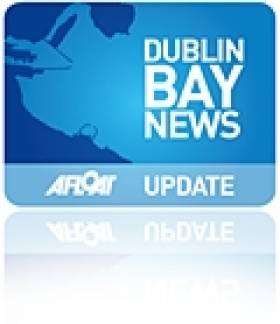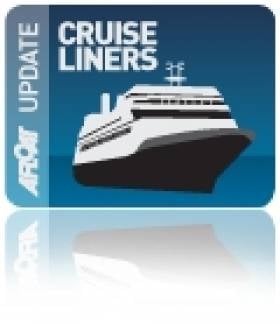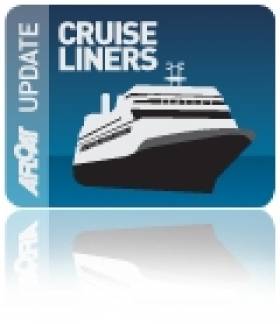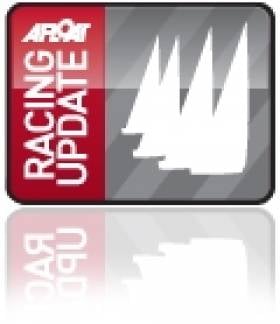Displaying items by tag: Dublin Port
Sheila Tyrrell to Chair New Sail Training Group
The new umbrella organisation Sail Training Ireland includes a number of key sailing people involved in sail training in Ireland including the chief executive of the Irish Sailing Association Harry Hermon and Seamus McLoughlin the head of operations of Dublin Port Company. The group also includes Kalanne O'Leary, a former member of Coiste an Asgard, the state board that ran Asgard II. The full group, chaired by Sheila Tyrrell, has been named as follows:
Sheila Tyrrell, Chair
Harry Hermon, ISA Chief Executive
Philip Cowman ISA Director, Ex Harbour Master Waterford
Kalanne O'Leary, Irish Representative on Sail Training International
Seamus McLoughlin, Head of Operations, Dublin Port
Sean Flood, Sail Training International Ambassador – Ireland.
Looking for further reading on Tall Ships in Ireland? Click the links below:
Click this link to read all our Tall Ships Stories on one handy page
Previewing Ireland's Tall Ships 2011 Season
Can Ireland Get a New Tall Ship?
Dublin Port Tugs Making Magic 'Rainbow' Happen
The spectacular effect of the life-size rainbow had never been achieved before in Ireland. Steve Green, the director of the advertisement used a 35mm film, with footage from HD cameras, including one mounted on the helicopter which hovered over the 'new' landmarks of the 'Docklands'.
The imaginative advertisement was created by Sweet Media, the production company chosen to produce the campaign, under the direction of the National Lottery's advertising agency, DDFH&B. The soundtrack for 'Making Magic Happen' is the appropriately titled 'Pocketful of Rainbows', sung by Elvis Presley. The version used is Take 16 from the 1960 recording sessions for the 'G.I. Blues' soundtrack.
As for the stars of the advert, the tugs are named after Irish figures, Shackleton, named in honour of Antartic explorer Sir Ernest Henry Shackleton and Beaufort, named after Navan-born, Sir Francis Beaufort, who created the world-renowned wind-scale measurement.
The 50-bollard ton tugs cost €6m each and were built at the Astilleros Zamakona Shipyard, Bilbao. In March the tugs officially entered service after a joint naming ceremony was held in Dublin Port.
To view the tugs in water-firing, making magic mode!... click the link here
Frostbite 'Cruising'
This morning the 28,388 gross tonnes cruises-ship Boudicca is due to arrive into Dublin Port, writes Jehan Ashmore. The visit of the 1973-built vessel will represent the second last cruise-call of this year's cruise-season. The 900-passenger capacity Boudicca will depart later today on a 10-day cruise to include calling to Cork.
The final cruise-call scheduled for Dublin Port will once again by made by Boudicca on 20 November. On that cruise the Fred. Olsen Cruise Lines ship will be returning from Cork after an overnight passage.
Next year Dublin is to welcome 86 cruise-ships, where the largest of these vessels will berth in Alexandra Quay, located 2 kms from the city centre. Smaller vessels can dock closer to the city-centre but they have to transit the East-Link toll-road lift bridge. In addition the depth of water on the River Liffey also restricts the size of cruise-ship.
Incidentally the Boudicca will be the first caller to Dublin in 2011, with a morning arrival due on 9 April. For further information on next year's cruise-call season, a list is available online at www.dublinport.ie/not-in-menu/cruise-ship-scheduled/
Ferry Passenger Boost Recorded for First Half of 2010
The figures reflect the disruption to the aviation industry due to the ash-cloud that erupted from the Icelandic Eyjafjallajokull volcanic mountain in April. This contributed to a large volume in passengers making alternative travel plans by booking with ferry operators.
During the week of the main closure to European air-space, ferry operators noted a three-fold increase in the demand for foot-passenger bookings throughout the main Irish Sea routes. The IMDO estimate that an additional 106,000 passengers took the ferry option compared to the same time period in 2009.
On the continental routes between Ireland to France, volumes increased 25% in the second quarter of 2010. There are three routes operated by four ferry operators. Over 30% of the passenger market is conducted within the second quarter of 2010, marking the beginning of the tourist season. Therefore any increase in passengers volumes from this time is likely to have a positive impact for the balance of the full year figures.
In the months between March to May, the increase in sea-passengers was up 14% year-on-year. While the market demand on English Channel routes, which accounts for 90% of the traffic, saw passenger numbers surge 13% in the second quarter of 2010 compared to the same timeframe of the previous year.
The largest percentage increase in traffic, was recorded at Dublin Port, during the first 6 months of 2010, where passenger volumes rose by 25%. Earlier in the year, a new entrant into the Irish Sea market, Fastnet Line re-opened the Cork-Swansea route. In 2006 the 10-hour route was closed by Swansea Cork Ferries. The new operator provides 6 sailings weekly which are likely to have resulted in a boost to passenger tourist vehicles in the south-west region.
On an all-Ireland basis there are 5 operators operating between Ireland and the UK, and 2 operators between Ireland and France providing 60 daily sailings. Irish Sea operators are Stena Line, Irish Ferries, P&O (Irish Sea), Seatruck Ferries and DFDS Seaways (formerly trading as Norfolkline) until acquired by the Danish ferry and transport logistics company. On the continental services, Irish Ferries and Celtic Link Ferries operate out of Rosslare Europort while Brittany Ferries serves the Cork-Roscoff route.
For a detailed PDF of the figures please click attachment listed below. For further information about the IMDO logon to their website: www.imdo.ie
Four Championships (and a Mega Party) Planned for Dun Laoghaire 2011
A number of classes have already committed to run open championships within the regatta including the Wayfarer UK and Irish Nationals, the J109 Open Championship, the SB3 Open Championship and a return match of the Irish Sea Championship in J80s between Ireland and Wales. The race management team headed up by Con Murphy, aided by the usual ocean of wonderful volunteers, are working to facilitate this to ensure the kind of quality race management and organisation that will ensure the success of these championships.
The non-spinnaker fleet was the largest fleet in the Regatta in 2009 and is expected again to top the numbers and provide great racing for large boats with a smaller crew.
The regatta combines the wonderful waterfront facilities of all 4 Dun Laoghaire clubs and includes support from other clubs in the Dublin area including Howth. There will be a full on entertainment programme for all participants and many more with the continued support of many of the sponsors of 2009 which included Volvo Cars, Dublin Port, Dun Laoghaire Rathdown County Council, The Royal Marine Hotel, Helly Hansen, Dubarry and many more.
One of the highlights of the regatta are the Ladies Lunches which will again be held across a number of the clubs on the Saturday. Top Fashion, great food, a dash of style accompanies by the glass of champagne are the order of the day. All these at a very reasonable price reflecting the realities of today's tightened purse strings.
There will be more announcements in the coming weeks.
For more information visit www.dlregatta.org or event secretary Ciara Dowling at [email protected]
Ships Meet In Dublin Port: Recall Collision in Dublin Bay
As the ro-ro ferry Norcape departed Dublin Port last Monday, on a routine sailing to Liverpool, the vessel passed the docked general dry-cargo bulker Wilson Tana. The vessels were involved in a collision in Dublin Bay, over 20 years ago, writes Jehan Ashmore.
On 18 February 1988 the vessels collided about a mile off the entrance to Dublin Port. The Norcape, was then under different ownership as B+I Line's 6,310grt Tipperary and the 4,694grt Wilson Tana, then named Sumburgh Head was owned by Norwegian shipping company Christian Salvesen.
Several small craft dashed to the scene as part of the rescue effort, fortunately the incident occurred close to the port and without loss of life or injury.
The bow of the Tipperary ruptured one of the Sumburgh Head holds, causing a large gash in hold No. 3 that led to over 3,500 tons of fertiliser spilling into the sea. The vessel was carrying in total 5,000 tonnes of the cargo from Rostock, then in the former East Germany.
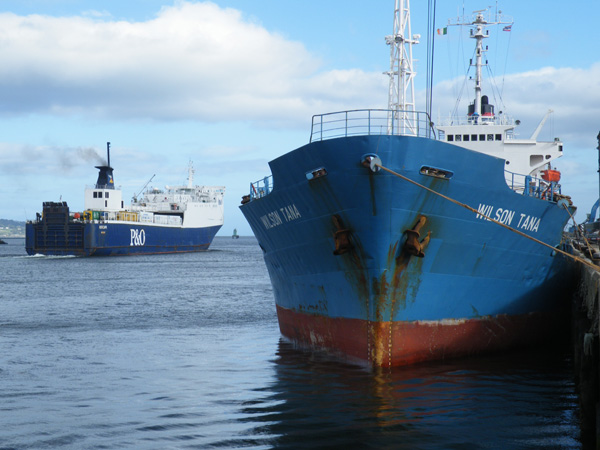
Norcape (formerly B+I Line's Tipperary) and Wilson Tana (formerly Sumburgh Head) in Dublin Port on Monday. Photo J. Ashmore /ShipSNAPS
Also arriving at the scene were tugs to assist the disabled vessels. The Sumburgh Head was in need of more urgent attention having sustained heavy structural damage amidships to one of four cargo holds. Several attempts were made to pull Sumburgh Head free while the Tipperary used her bow thrusters and main engines in an attempt to pull away too.
After an hour the vessels parted, though air-sea rescue services were called as it was feared the Sumburgh Head was in a vulnerable situation. The vessel only developed a 10-degree list and limped into the port under towage. Tipperary was less damaged and managed to return to port under her own power.
Sumburgh Head received remedial attention with metal girders positioned across the gapping damaged hold. In comparison the Tipperary was less damaged except for a gash to the bow and several buckled bulbous bow plates. The ferry received repairs in the local dry-dock facility in Alexandra Basin.
The Sumburgh Head was built in 1977 at the Hashihama Zosen shipyard, Imabari in Japan. Incidentally, Tipperary was also built in Japan by Mitsui Engineering Shipbuilding, Tamano and launched in 1979. The newbuild was chartered to B+I Line to serve on a new Dublin-Fleetwood route jointly operated with P&O, using Tipperary's sister, Ibex.
In 1988, the route's UK port switched to Liverpool with Tipperary remaining on the route until sold to North Sea Ferries in 1989 and renamed Norcape. It is only this year that the vessel returned to Dublin-Liverpool for P&O (Irish Sea) completing a career circle.
As for Wilson Tana, the Maltese flagged bulker docked in Dublin after arriving from Gijon, northern Spain. For the next two days the vessels cargo of sand was unloaded at the Coal Quay before departing last night.
Honouring Sean 'Dublin Bay' Loftus
The Big One: Azura Cruises into Dublin
As the cruise season draws to a close, the Azura, the largest cruise-ship (116,000 gross registered tonnes) to call at Dublin, docked this morning at the port for the third time this year, writes Jehan Ashmore.
A unique feature is the huge 20-metre plasma screen video wall mounted on an after bulkhead. In addition the venue is used to broadcast major sporting events. The Sea Screen outdoor cinema is the first of its kind in the P&O Cruises fleet as is the novelty of passengers having an option of
single stateroom accommodation.
Azura is one of 12 vessels eminating from the 'Grand' class vessels built for Miami based Carnival Cruise Corporation which includes P&O Cruises and Princess Cruises. The leadship, Grand Princess became the first of the class to call at Dublin in 2004 and also had the distinction as the first cruiseship to surpass the 100,000gt mark to dock at the port. Last month, another near-sister, Emerald Princess, measuring 113,000grt called to Dublin.
In total there will be 86 cruise ships visiting Dublin this year, marking another record-breaking season. The sector is expected to generate €35-€55m to the local economy from approximately 80,000 high-spending passengers.
The Azura departs Dublin tonight at 21.15hrs for Cork, where the giant vessel is to berth at the Cobh Cruise Terminal. There will be off-season cruise-calls to the capital next month by Ocean Countess and Norwegian Sun, arriving from Belfast on 2 October. The last cruise-caller to Dublin this year will
be Fred Olsen Cruises Boudicca with two visits in November.
Graceful Lady Liner to Visit Dublin
The vessel was launched as Port Sydney in 1955 from Swan Hunter and Wigham Richardson Yards, Wallsend-on-Tyne for Port Line, a subsidiary of Cunard Line. With five cargo holds, the vessel served both the meat trade and carried passengers on liner-route services between the UK and New Zealand and Australia via the Panama Canal.
In 1974, Port Sydney underwent a radical conversion into a luxury passenger cruise ship, despite the exterior appearance the vessel retains a pleasant profile compared to many modern cruiseships. Over the decades the vessel had different owners and several vessel name changes; Daphne, Switzerland and Ocean Monarch.
The most refit was in 2008 and the ship still retains the largest cabins found on any cruise ship today, of the 241 cabins. With spacious cabins for only 550 passengers and attractive appointed public areas and wide exterior decks, the veteran provides a form of cruising that would appeal to classic cruise aficionados around the world.
With a strong and sturdy hull, the vessel has a deep draft which is well suited to an ocean going vessel in handling inclement weather, though the large draft does restrict visiting certain ports and anchorage locations.
Sistership, Princess Danae, formerly Port Melbourne, was also built in 1955 with the second newbuild ordered to the famous Belfast shipbuilders, Harland & Wolff. Princess Danae is slightly smaller at 15,833grt and also made a recent call in Dublin. The sisters form part of a six vessel fleet operated by Classic International Cruises.
Princess Daphne is due to arrive in Dublin after an overnight passage from Plymouth, docking at 08.00 and depart the capital at 17.45hrs. In addition the port expects another cruise-call tomorrow in the form of Prinsendam of 37,983 grt and with over a 800-passenger capacity. The Dutch flagged vessel is operated by Holland America Line and is due to dock around mid-moring and depart at 23.30hrs.
Fitzpatrick and McDonald Win Inaugural Liffey Skiffy
Crashes and capsizes were on order for spectators from the first start with Ed Butler and Dermot Mc Murrough suffering a mainsail tear from the first start. Nin O'Leary also made the most of a capsize by back flipping from the boats wing once semi turtle! Many photos were made available from the event with the most notable making the front page of Saturday's Irish Times newspaper!
Many thanks go to the event sponsors OnBoard Surf Snow Sail, PR Reilly Car accessories as well as Dublin Port Company, Dublin Docklands Authority, The National YC, St. Patricks Rowing Club and the International 49er Class Association.

Action on the Liffey. Photo: Harry Hermon




























